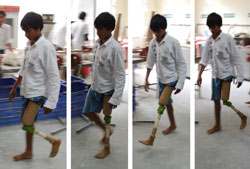Collaborations spur biomedical innovations
September - October, 2009 | Volume 8, Issue 5
When an intravenous drip is not available in resource-poor areas, the only way to deliver fluids is through the bone, especially in children.
A device to do just that costs about $10,000 in the United States, but a collaboration between Stanford University and research teams in India has produced an intraosseous fluid delivery system that can be produced locally for under $2.
The intraosseous device and an artificial knee costing only $20 are among the success stories of the eight-year-old Stanford-India Biodesign, a program that unites researchers, engineers, designers and business students to develop technology to improve health and catalyze growth of biomedical industry in the world's second largest nation.
The program was featured at the recent meeting at the NIH of the new Consortium of Universities for Global Health.

Photo by Joel Sadler, Jaipur Foot Organization
A US-India collaboration has produced several
inexpensive devices ideal for use in poor countries.
Kamal, 17, whose leg was amputated above the
knee, demonstrates the ease of motion of his new
artificial limb, developed by the Stanford India
Biodesign project.
"We feel innovation is something that can be taught," Srivastava said. "It is a discipline. It requires diligence."
Advanced students are selected from around the world to participate in the highly structured program, which begins with "clinical immersion" for those who are not trained in medicine. Teams of four are taught to observe unmet clinical needs, catalogue them and come up with one or two for which innovative solutions can be developed, modeled and brought to market.
The Stanford researchers collaborate with counterparts from the All India Institute of Medicine and the Indian Institute of Technology to address needs in that country.
"It's an opportunity to really alleviate human suffering on a large scale and to help catalyze an industry that fosters a sustainable model," Srivastava explained. The hope is "to create a global paradigm that is replicable to other parts of the world."
To view Adobe PDF files,
download current, free accessible plug-ins from Adobe's website.